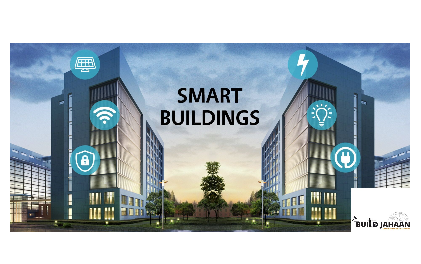
The growing demand for sustainability and energy efficiency in the infrastructure sector has led to the development of a new and exciting concept of smart buildings. Smart buildings also known as intelligent buildings are structures that use a variety of technologies to optimize the performance, comfort, and safety of occupants while simultaneously reducing energy consumption. Smart buildings use an array of sensors, actuators, and microchips which are controlled and operated remotely to collect and manage data according to business requirements. Making a building smart leads to increased asset reliability and performance, optimum space utilization, and reduced adverse impact on the environment. While conventional buildings do provide the essentials like shelter, safety & serviceability; smart buildings or older structures retrofitted to serve as smart buildings are living organisms wired with intelligent and adaptable software linking elemental systems like lighting, water meters, fire alarms, and other electronics with sensor controls and now you can book all construction materials at very low price.
Creation of smart buildings:
Smart buildings usually include building automation systems, internet of things (IoT) sensors, and cloud-based analytics which manage and share information to automate processes such as lighting, heating or cooling, ventilation, security, etc but are not necessarily restricted to just this. This is what fundamentally makes a building smart; the ability of these connected systems to interact with one another. There is no single set of standards to be followed for a building to be called a smart building but all such buildings do have one thing in common: integration.
Building automation systems centralize building management by controlling HVAC equipment, lighting security, and other building systems from a single interface. Usually, IoT sensors are installed in walls or floors during the erection of the building and they collect real-time data on various parameters like temperature, humidity, or occupancy. This data is then used to continuously optimize building efficiency. For example, sensors can detect the temperature of a particular room & if the temperature is too high or low, the building automation system would adjust it automatically by controlling HVAC equipment. Similarly, sensors can detect occupancy and BAS would automatically turn off the lights in that particular area to save energy.
Benefits of smart buildings:
The benefits of creating or transforming a smart building are far and wide ranging from energy efficiency, safety & productivity gains to economy, aesthetics & sustainability. Commercial buildings which are built smart have the potential to increase the productivity of the facility staff, support sustainability and improve overall building operation. Examples of energy efficiency can be using a building automation system for optimal start/stop to bring the air conditioning system online at a particular time for a particular zone of the building or grouping electrical loads from high priority to non-essential so that when the building load rises; non-essential electrical loads are automatically turned off. The apparent benefits of smart buildings are highlighted below:
Comfort: A major upside of smart buildings is the comfortable environment it provides for occupants by automatically adjusting HVAC parameters using building automation systems. These settings can even be adjusted according to the preferences of individuals.
Safety: Building automation systems keep a tab on diversified potential hazards like pipe leaks, CO2 levels, and smoke as well as control safety features like security cameras and access control systems and alert building managers if urgent action is needed.
Maintenance: Though the initial construction cost is high but smart buildings are usually easier to maintain compared to conventional buildings. BAS automatically identifies faulty systems needing maintenance or repair and can even schedule them automatically which in turn reduces the downtime and improves the overall lifespan of the structure.
Increased property value: With young tenants willing to spend more on comfort, convenience, and safety, smart buildings are becoming increasingly popular, and having such connected features in the building will give property value a push to property owners.
Impact of smart buildings:
A far-reaching impact of smart buildings is that they reduce energy consumption by optimizing performance thus generating significant cost cuts and environmental benefits. Smart buildings cater to the increased flexibility of buildings in terms of use as they exhibit the ability to adapt to changing requirements. In addition to improving occupant comfort and convenience, they lead to greater satisfaction and retention rates.
Smart buildings will also boost the economy by promoting technology & innovation. They will drive new jobs in the technology as well as the infrastructure sector. Also, as stated earlier, they will lead to significant cost savings in the commercial sector stimulating economic growth and development.
In the world of building automation, smart buildings are an exciting development that has the potential to transform our very thinking about building design, construction, and management. Smart buildings will incorporate advanced technology to provide increased energy efficiency, occupant comfort, and building management. With exciting benefits for both owners and occupants, the future of building design is likely to be predominated by more sophisticated smart buildings in the future.